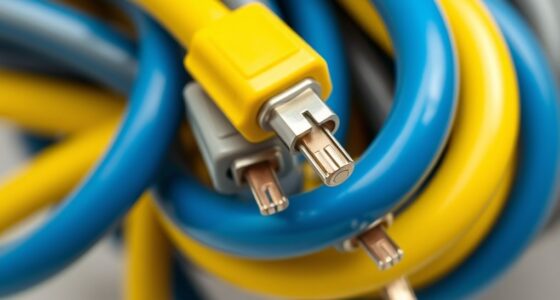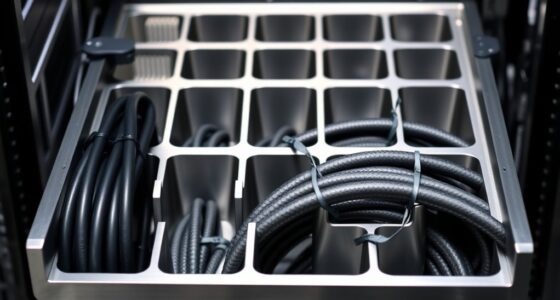If you’re looking for reliable PoE-powered switches, I recommend considering options like NETGEAR, TP-Link, and other well-rated brands that support standards such as 802.3af, 802.3at, and 802.3bt. These switches provide multiple ports, flexible deployment options, and sufficient power budgets for devices like IP cameras and VoIP phones. Many also feature easy setup and management tools, ensuring your network stays stable and efficient. Keep exploring to find the best fit for your needs.
Key Takeaways
- Opt for switches supporting IEEE 802.3af/at/bt standards for broad device compatibility and future-proofing.
- Prioritize models with sufficient PoE power budget and multiple ports to support various devices simultaneously.
- Consider managed or smart switches offering security features, remote management, and network monitoring for reliability.
- Look for durable, versatile designs with mounting options suitable for different deployment environments.
- Check for scalability features like SFP ports and uplink options to expand network capacity easily.
PoE Passthrough Switch, 1 PoE In 3 PoE Out Extender

Are you looking for an easy way to extend your PoE network without the hassle of installing additional power outlets? The PoE Passthrough Switch, with 1 PoE input and 3 PoE outputs, is perfect for this. It supports IEEE 802.3af/at standards and delivers up to 24W per port, powering devices like cameras, access points, or VoIP phones directly through the network. Its compact, lightweight design makes installation simple—wall or din-rail mounting is a breeze. Plus, it supports cascading for expanded coverage. No extra power adapters needed, making it a cost-effective, plug-and-play solution for extending your PoE coverage effortlessly.
Best For: individuals or businesses seeking an easy, cost-effective way to extend PoE network coverage without additional power outlets or complex setup.
Pros:
- Supports standard IEEE 802.3af/at PoE for reliable device powering
- Compact and lightweight, suitable for wall or din-rail mounting
- Enables cascading for expanded network coverage and device connectivity
Cons:
- Limited to 100 Mbps data rate, which may be insufficient for high-bandwidth needs
- Not compatible with passive 24V PoE devices, restricting use with certain equipment
- Max 30W input power may limit the number or power of connected devices
NETGEAR 8 Port PoE Gigabit Ethernet Switch

The NETGEAR 8 Port PoE Gigabit Ethernet Switch is an excellent choice for small to medium-sized networks that require reliable Power over Ethernet connectivity. It offers eight Gigabit Ethernet ports, with all eight supporting PoE+ and a total power budget of 123W, making it ideal for powering IP cameras, VoIP phones, or wireless access points. Its flexible placement options include desktop or wall mounting, saving space. The easy Smart Managed Essentials software provides straightforward configuration, security, and monitoring. With energy-efficient design, IEEE802.3az compliance, and a silent operation, this switch guarantees dependable, quiet performance backed by a 3-year hardware warranty.
Best For: small to medium-sized businesses seeking reliable, energy-efficient PoE network connectivity with easy management and flexible installation options.
Pros:
- Supports 8 PoE+ ports with a total power budget of 123W, suitable for powering multiple devices simultaneously
- User-friendly Easy Smart Managed Essentials software enables straightforward configuration and monitoring
- Compact design with desktop or wall mount options, plus silent operation for noise-sensitive environments
Cons:
- Limited to basic managed capabilities without advanced features like VLANs or link aggregation
- Designed for use in U.S. & CA only, limiting international compatibility
- No additional features such as fiber optic ports or redundant power supply options
TP-Link TL-SG1005P 5-Port Gigabit PoE Switch

If you’re setting up a small network and need a reliable, plug-and-play PoE switch, the TP-Link TL-SG1005P is an excellent choice. It offers five ports, with four PoE+ ports delivering up to 30W per port and a total power budget of 65W, perfect for powering IP cameras, access points, or other PoE devices. The switch is unmanaged, so setup is quick—just plug in and go. Its sturdy metal case supports desktop or wall-mount placement, and its silent fanless design ensures quiet operation. With gigabit speeds, solid build quality, and a three-year warranty, this switch combines simplicity and performance for small network needs.
Best For: small businesses or home users seeking a reliable, easy-to-use PoE switch for powering security cameras, access points, and other PoE devices without complex management.
Pros:
- Plug-and-play setup with no need for configuration
- Durable metal case and silent fanless operation for quiet environments
- Supports gigabit speeds and up to 30W PoE per port for high-performance device powering
Cons:
- Lack of advanced management features like SNMP or VLAN support
- Limited to 5 ports, which may be insufficient for larger networks
- Dip-switch customization options are minimal and mostly unused by typical users
TP-Link TL-SF1005P 5-Port Fast Ethernet PoE Switch
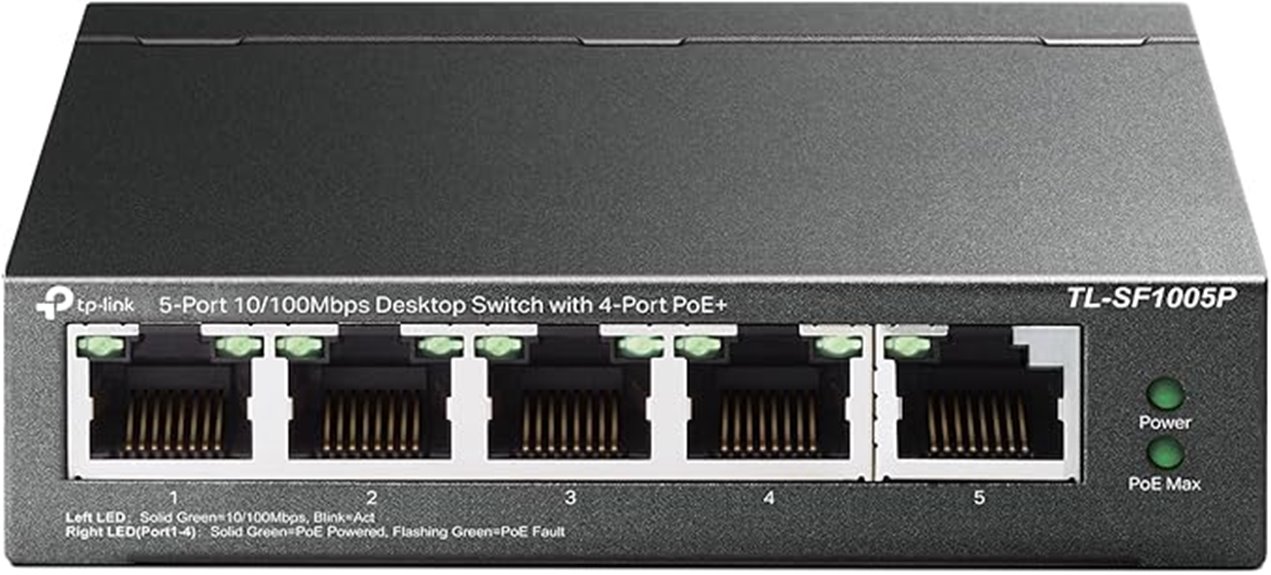
Designed for small businesses or home offices, the TP-Link TL-SF1005P 5-Port Fast Ethernet PoE Switch offers a straightforward solution for expanding network connectivity while powering compatible devices. Its durable metal casing can be desktop or wall-mounted, and the fanless design guarantees quiet operation. With four PoE+ ports providing up to 30W each and a total power budget of 67W, it supports devices like IP cameras, access points, and IP phones. The plug-and-play setup is simple, requiring no configuration. Its reliable build, extend mode for longer reach, and positive customer ratings make it an excellent choice for those seeking a compact, efficient PoE switch.
Best For: small businesses or home offices seeking an easy-to-use, reliable PoE switch to expand network connectivity and power compatible devices.
Pros:
- Easy plug-and-play setup with no configuration required
- Durable metal casing with flexible mounting options and fanless operation for silent performance
- Supports PoE+ with a total power budget of 67W, suitable for powering IP cameras, access points, and IP phones
Cons:
- Limited to 100 Mbps per port, which may not meet high-bandwidth needs
- Only 5 ports (some descriptions mention 8, but primarily 5) may restrict expansion options
- No managed features, limiting advanced network control or customization
TP-Link LS108GP 8-Port PoE Gigabit Ethernet Switch
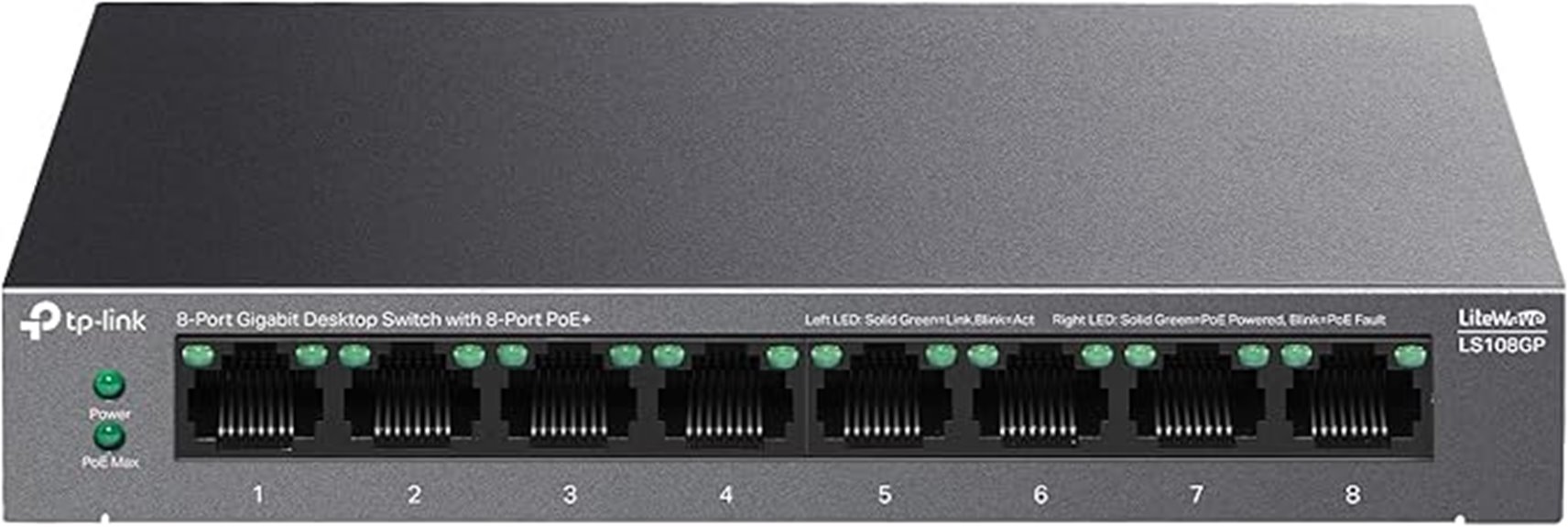
For small businesses or home users seeking reliable, straightforward PoE solutions, the TP-Link LS108GP 8-Port PoE Gigabit Ethernet Switch offers an ideal combination of performance and ease of use. Its durable metal case and silent fanless design make it suitable for various environments. With 8 PoE+ ports supporting up to 30W each and a total power budget of 65W, it efficiently powers devices like cameras or access points. The switch supports full gigabit speeds and PoE Auto Recovery for network reliability. Its plug-and-play setup simplifies installation, and its compact size makes it a versatile choice for both desktop and wall mounting.
Best For: small businesses and home users seeking a reliable, easy-to-install PoE switch for powering cameras, access points, and other network devices.
Pros:
- Easy plug-and-play setup for quick deployment
- Durable metal case with silent fanless operation for noise-sensitive environments
- Supports PoE Auto Recovery, enhancing network reliability
Cons:
- Limited total PoE power budget of 65W, which may restrict the number of high-power devices powered simultaneously
- Only 8 ports, which might be insufficient for larger network setups
- No advanced management features such as VLAN configuration or QoS
16 Port PoE Switch Unmanaged with 16 PoE+ Ports, 250W Power, 2 Gigabit Uplink, 1 SFP, VLAN Mode, AI Watchdog, RackMount
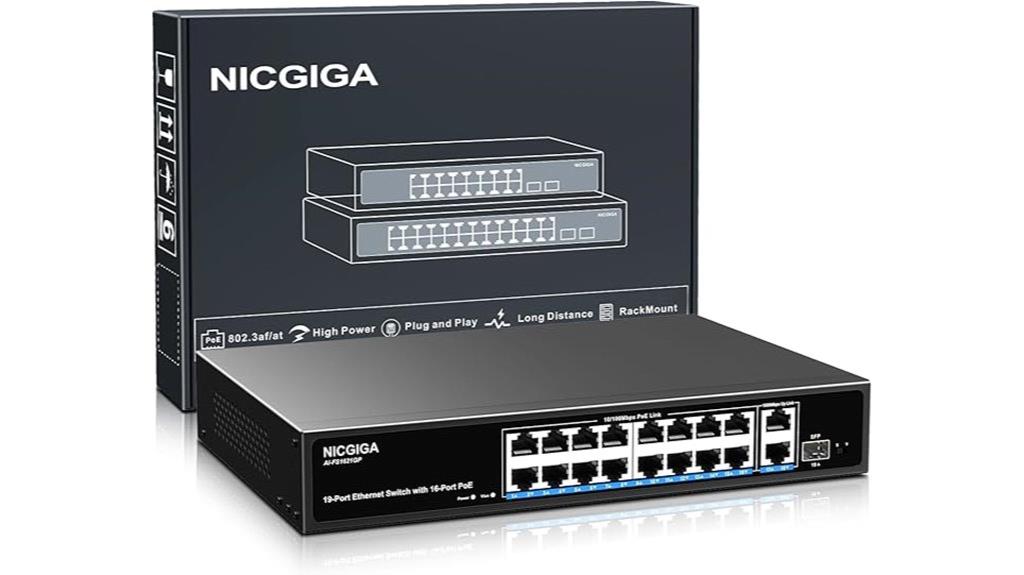
The NICGIGA 16-port PoE switch is an excellent choice for network administrators seeking a reliable, plug-and-play solution to power and connect multiple PoE+ devices. It offers 16 ports with a total power budget of 250W, supporting IEEE802.3af/at standards and automatic PD detection. The switch includes 2 Gigabit uplink ports and an SFP port for flexible network expansion. Its VLAN mode enhances security by isolating ports, while AI Watchdog technology automatically detects and recovers offline devices. With a sturdy metal housing, rackmount compatibility, and lightning protection, this unmanaged switch guarantees stable, efficient, and secure network operation.
Best For: network administrators seeking a reliable, plug-and-play PoE switch to power and connect multiple PoE+ devices in small to medium-sized setups.
Pros:
- Supports 16 PoE+ ports with a total power budget of 250W, ideal for powering multiple devices simultaneously
- Equipped with AI Watchdog technology for automatic detection and recovery of offline PoE devices, reducing maintenance efforts
- Features VLAN mode for enhanced security and network segmentation, along with durable metal housing and lightning protection
Cons:
- As an unmanaged switch, it lacks advanced configuration and management features found in managed switches
- Limited to 2 Gigabit uplink ports and 1 SFP port, which may restrict scalability in larger networks
- No included power supply, requiring compatible power sources for operation
NETGEAR 8-Port PoE+ Gigabit Ethernet Switch (GS308PP)

If you’re looking for a reliable and straightforward solution to power multiple PoE devices, the NETGEAR GS308PP is an excellent choice. This unmanaged 8-port Gigabit switch offers a total PoE+ power budget of 83W, perfect for IP cameras, VoIP phones, and other PoE-enabled gear. Its plug-and-play design means no configuration is needed, and you can mount it on a desk or wall for versatile deployment. Built with a durable metal case, it’s compact and lightweight. Backed by a 3-year warranty, it provides dependable performance with data transfer speeds of up to 1Gbps per port, making it a practical, cost-effective option.
Best For: small to medium-sized businesses or home offices seeking a reliable, plug-and-play PoE switch for powering IP cameras, VoIP phones, and other PoE-enabled devices.
Pros:
- Easy plug-and-play setup with no software or configuration needed
- Compact and durable metal design suitable for desktop or wall mounting
- 83W total PoE+ power budget efficiently supports multiple PoE devices
Cons:
- Unmanaged switch offers limited network customization options
- Limited to 8 ports, which may not suffice for larger setups
- No advanced features like network management or VLAN support
TP-Link TL-SG105 5-Port Gigabit Ethernet Switch

The TP-Link TL-SG105 5-Port Gigabit Ethernet Switch is an excellent choice for small networks that need reliable, high-speed wired connectivity without complex configuration. Its 10/100/1000Mbps ports with Auto Negotiation and Auto MDI/MDIX make setup simple—just plug and play. Built with energy-efficient technology, it reduces power consumption while maintaining strong performance. The sturdy metal casing guarantees durability, and the fanless design keeps operation quiet. Features like QoS and IGMP Snooping prioritize critical traffic, enhancing performance. With wall-mount options and a 3-year warranty, this switch offers a dependable, flexible solution for expanding network capacity effortlessly.
Best For: small businesses or home offices seeking a reliable, easy-to-install gigabit switch for expanding wired network connections.
Pros:
- Simple plug-and-play setup with auto-negotiation and auto MDI/MDIX ports
- Energy-efficient design reduces power consumption without sacrificing performance
- Durable metal casing and fanless operation ensure quiet and long-lasting use
Cons:
- Limited to unmanaged switch capabilities, lacking advanced configuration options
- No built-in management features for network monitoring or customization
- Fixed number of ports (5), which may require additional switches for larger networks
NETGEAR 8-Port PoE Gigabit Ethernet Managed Switch (GS308EP)

For network administrators seeking a reliable, easy-to-manage switch with PoE capabilities, the NETGEAR GS308EP stands out. It offers 8 Gigabit Ethernet ports, all with PoE+ support, providing a total power budget of 62W—perfect for powering IP cameras, VoIP phones, and wireless access points. Its Easy Smart Managed Essentials software features a user-friendly interface, making configuration, security, and monitoring straightforward. Plus, it supports both desktop and wall-mount options for flexible deployment. Backed by an industry-leading 3-year warranty, the GS308EP combines affordability, performance, and ease of use for small to medium-sized networks.
Best For: small to medium-sized network administrators seeking a reliable, easy-to-manage PoE switch with flexible mounting options.
Pros:
- User-friendly Easy Smart Managed Essentials software for simple configuration and monitoring
- 8 PoE+ ports with a total power budget of 62W ideal for powering IP cameras, phones, and access points
- Supports both desktop and wall-mount installation for flexible deployment
Cons:
- Limited to 8 ports, which may not suffice for larger network needs
- No advanced Layer 3 management features included
- The 62W power budget might be insufficient for multiple high-power PoE devices simultaneously
Gigabit PoE Switch, 2 Port Ethernet Switch, PoE Adapter
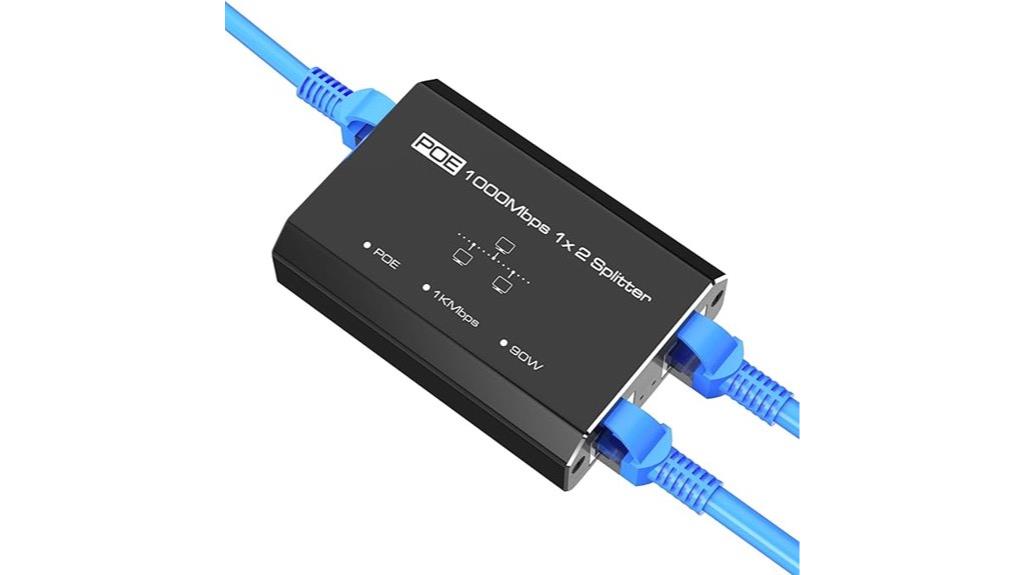
A Gigabit PoE switch with 2 ports offers an ideal solution for small-scale network setups that need reliable power and data transmission over short distances. It provides two Gigabit ports with integrated PoE support, delivering up to 30W of power per port and supporting standards like 802.3af/at. This plug-and-play device simplifies deployment by requiring no configuration, and it can extend network reach up to 328 feet. Constructed from durable aluminum alloy, it guarantees stable signal quality and resistance to damage. Whether powered via PoE or an external adapter (not included), it’s perfect for connecting IP cameras, access points, and other PoE devices in compact environments.
Best For: small businesses, home offices, or AV setups needing reliable, short-distance Gigabit PoE networking with easy installation.
Pros:
- Supports up to 30W PoE+ power for multiple devices
- Plug-and-play design requires no configuration
- Durable aluminum alloy construction ensures signal stability and long-term use
Cons:
- External power adapter not included, which may add to setup complexity
- Limited to 2 ports, suitable only for small-scale networks
- Distance extension capped at 328 feet, not ideal for larger installations
Gigabit PoE Passthrough Switch with 4 Ports

If you’re looking to extend PoE coverage efficiently, the Gigabit PoE Passthrough Switch with 4 Ports offers an ideal solution. It supports a single PoE input and four Gigabit output ports, providing up to 1000 Mbps speeds. Powered entirely through PoE, it eliminates the need for an external power source, making installation simple and space-saving with its compact metal design suitable for wall mounting or DIN rail setups. It supports IEEE 802.3af/at/bt standards, with a maximum input power of 90W. Plus, its VLAN feature enhances security, while plug-and-play operation means you can connect multiple devices like cameras, access points, or phones instantly.
Best For: small to medium-sized businesses or setups requiring efficient PoE extension for cameras, access points, and VoIP phones without additional power adapters.
Pros:
- Powered entirely through PoE, no external power needed, simplifying installation
- Supports IEEE 802.3af/at/bt standards with high power output, suitable for various devices
- Compact, wall-mountable design allows for versatile installation options
Cons:
- Not compatible with 24V passive PoE, limiting compatibility with some legacy devices
- Limited to 4 output ports, which may be insufficient for larger setups
- Slightly higher weight and size compared to basic switches, which may impact space in tight environments
NETGEAR 10-Port PoE Gigabit Ethernet Smart Switch (GS110TP)

The NETGEAR GS110TP stands out as an ideal choice for small to medium-sized businesses seeking a reliable, managed PoE switch with flexible deployment options. It offers 8 PoE+ ports with a total power budget of 55W, making it perfect for powering IP cameras, VoIP phones, and wireless access points. The switch includes 2 Gigabit SFP ports for fiber connections, enhancing scalability. Its smart management software provides an easy-to-use interface for secure setup, remote control, and SNMP management via NETGEAR Insight. Designed for desktop or wall-mount installation, it combines energy efficiency with a limited lifetime warranty and next-business-day replacement, ensuring dependable, flexible network performance.
Best For: small to medium-sized businesses seeking a reliable, managed PoE switch with flexible deployment options.
Pros:
- Supports 8 PoE+ ports with a total power budget of 55W, ideal for powering IP cameras, VoIP phones, and wireless access points
- Includes 2 Gigabit SFP ports for fiber connectivity, enhancing scalability
- Features easy-to-use management software with secure setup, remote control, and SNMP management via NETGEAR Insight
Cons:
- Limited total PoE power budget may restrict the number of powered devices during high-demand scenarios
- No built-in advanced security features beyond basic access control
- May require some technical knowledge for optimal configuration and management
Factors to Consider When Choosing a Poe Powered Network Switch
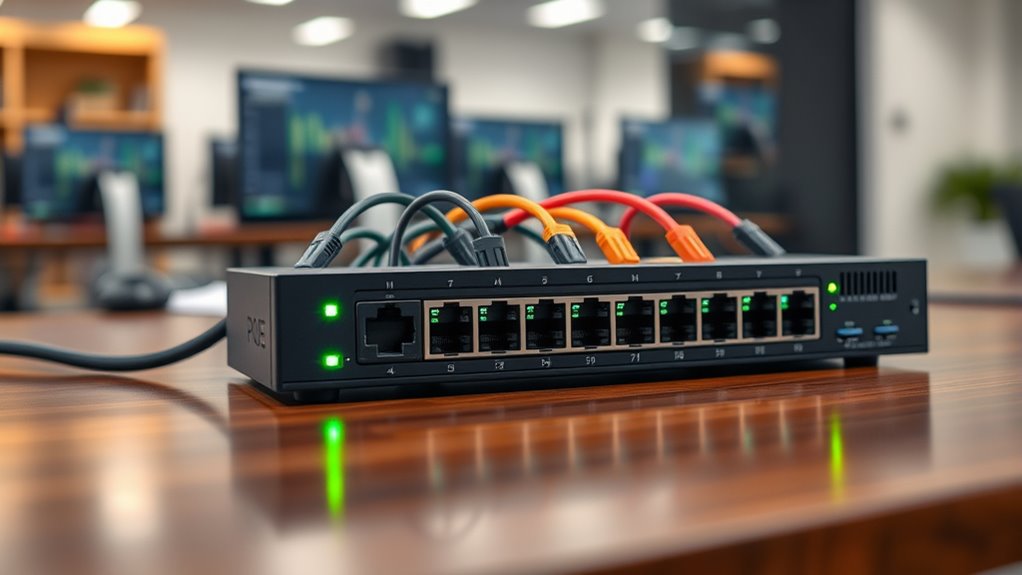
When selecting a PoE-powered network switch, I consider several key factors to guarantee it meets my needs. These include power budget capacity, port options, installation flexibility, compatibility standards, and management features. Understanding these points helps me choose a switch that’s reliable, scalable, and easy to secure.
Power Budget Capacity
Choosing a PoE switch with the right power budget capacity is essential because it directly impacts your ability to power all your connected devices reliably. The power budget determines the total wattage available to support multiple PoE devices simultaneously. Higher power budgets, like 250W or 370W, let you power more devices or higher wattage ones such as PTZ cameras or multiple access points. It’s important to match the switch’s total wattage to your current and future needs, considering both individual port requirements and overall capacity. IEEE standards like 802.3af and 802.3at specify maximum wattages per port, which helps in planning. Ensuring the power budget is sufficient prevents devices from losing power or the switch from overloading, maintaining reliable operation.
Port Availability & Types
Making certain your switch has enough ports is crucial for supporting all current devices and allowing room for future expansion. I recommend checking the number and types of ports to match your network needs. For instance, Gigabit Ethernet ports provide faster speeds than Fast Ethernet, which is essential for high-bandwidth applications. It’s also important to verify if the switch supports PoE+ (802.3at) or only PoE (802.3af), as this determines the power available for your devices. Additionally, determine whether the switch has dedicated uplink ports or combo ports, offering flexibility in network topology. Finally, review the total PoE power budget to ensure it can supply sufficient power to all connected devices simultaneously. These factors help optimize your network’s performance and scalability.
Installation Flexibility Options
Selecting a PoE network switch with installation flexibility is vital for fitting different environments and future needs. Look for switches that support multiple mounting options like wall mount, DIN-rail, or desktop placement, making setup adaptable to various spaces. Consider whether the switch allows cascading or daisy-chaining to extend network coverage without extra equipment. Easy plug-and-play setup is necessary for quick deployment, minimizing configuration time. Check if the switch supports different power sources, such as PoE input and external adapters, to suit diverse installation environments. Additionally, LED indicators and port status lights help with straightforward monitoring during installation and maintenance. These features guarantee you can install your switch efficiently and adapt it as your network grows or changes.
Compatibility Standards & Features
When evaluating PoE network switches, it’s vital to verify that they support the relevant IEEE standards such as 802.3af, 802.3at, or 802.3bt, since these guarantee compatibility with your PoE devices and their power needs. Make certain the switch provides a sufficient total PoE power budget and per-port wattage to support devices like cameras and VoIP phones effectively. Check if it offers PoE auto-recovery and automatic device detection for seamless, maintenance-free operation. Compatibility with the voltage range of 44-57 Vdc, as specified by standard PoE protocols, is key for safe and efficient power delivery. Additionally, features like VLAN support, QoS, and port isolation can enhance network security and traffic management, making your deployment more reliable and manageable.
Management & Security Features
Choosing a PoE network switch with robust management and security features can substantially improve your network’s reliability and protection. Managed switches offer advanced security options like VLAN segmentation, access controls, and SNMP monitoring, helping prevent unauthorized access and isolate sensitive devices. While unmanaged switches are simpler and lack these features, they’re suitable for basic setups. Security features like port-based VLANs and auto device detection help secure connected PoE devices. Additionally, switches with PoE auto recovery and AI watchdog technology boost reliability by automatically rebooting unresponsive devices. Management capabilities, such as remote configuration and real-time monitoring, allow me to enforce security policies and quickly identify potential threats. These features are essential for maintaining a secure, stable, and easily manageable network environment.
Frequently Asked Questions
How Does Poe Power Consumption Affect Overall Network Energy Efficiency?
PoE power consumption directly impacts my network’s energy efficiency because higher power needs mean more energy is used overall. When I choose switches with efficient power management, I reduce waste and lower energy costs. I pay attention to switches that support PoE standards like IEEE 802.3at or 802.3bt, which help optimize power use without sacrificing performance. This way, I keep my network reliable and energy-efficient.
Can Poe Switches Support Future Network Upgrades and Higher Power Demands?
Yes, PoE switches can support future upgrades and higher power demands, especially if you choose models with higher power budgets and scalable features. I’ve found that modern switches often come with adjustable power outputs and compatibility with upcoming standards like PoE++ or 4PPoE. This flexibility makes certain your network remains ready for future devices, making it a smart investment for growth without constant replacements or upgrades.
What Security Features Are Available on Advanced Poe Switches?
Advanced PoE switches often include security features like IP source guard, dynamic ARP inspection, and port security to prevent unauthorized access. They also support VLAN segmentation, 802.1X authentication, and encrypted management protocols like SSH and SNMPv3. These features help protect your network from threats, ensuring data integrity and privacy. I recommend choosing switches with robust security options to keep your network safe and resilient against cyberattacks.
Are There Compatibility Issues Between Different Brands of Poe Devices?
Did you know over 70% of network issues stem from device compatibility? When it comes to PoE devices, I’ve found that compatibility between brands can be tricky. Sometimes, different brands don’t fully support each other’s standards, leading to power or connectivity problems. To avoid this, I recommend sticking with devices that follow the same PoE standard, like IEEE 802.3af or 802.3at, and checking manufacturer compatibility lists before purchasing.
How Do Environmental Factors Influence Poe Switch Performance and Longevity?
Environmental factors considerably impact PoE switch performance and longevity. I’ve noticed that high temperatures can cause overheating, reducing device lifespan, so proper ventilation is vital. Humidity also matters; excessive moisture can lead to corrosion and electrical issues. Dust and dirt clog vents, impairing cooling. To keep my PoE switches running smoothly, I make sure they’re installed in clean, climate-controlled environments with adequate airflow, which helps maintain reliable connectivity and extends their life.
Conclusion
Think of choosing a PoE switch like selecting the right conductor for an orchestra. When you pick the perfect switch, all your devices perform harmoniously, delivering a symphony of reliable, efficient connectivity. With the right choice, your network becomes a well-orchestrated masterpiece, vibrant and seamless. So, consider your needs carefully, and let your network play on without missing a beat. Your connectivity’s future depends on the conductor you choose today.


